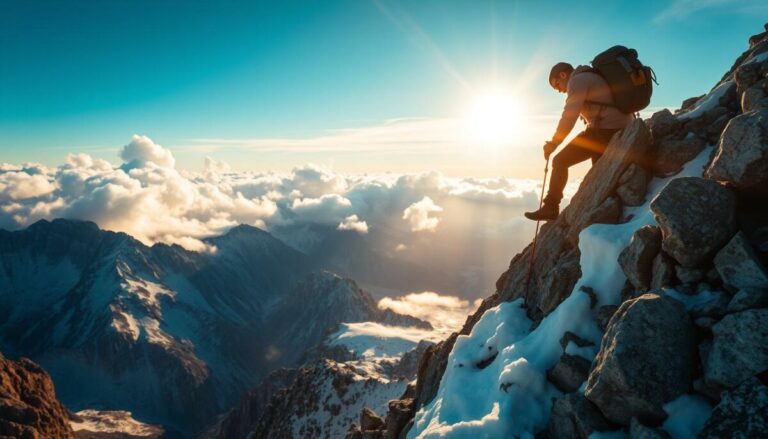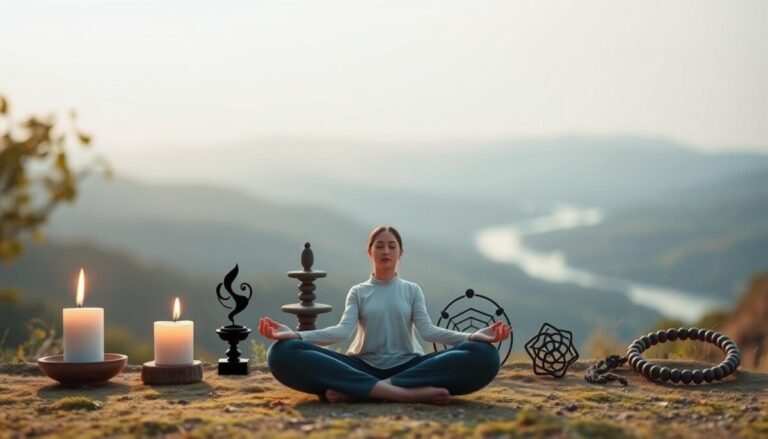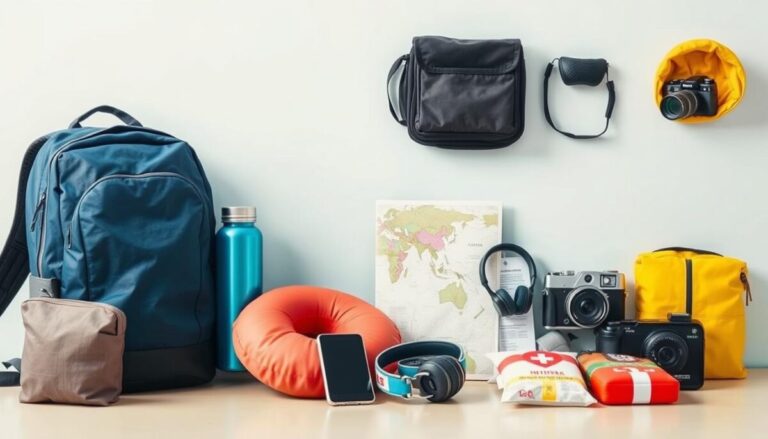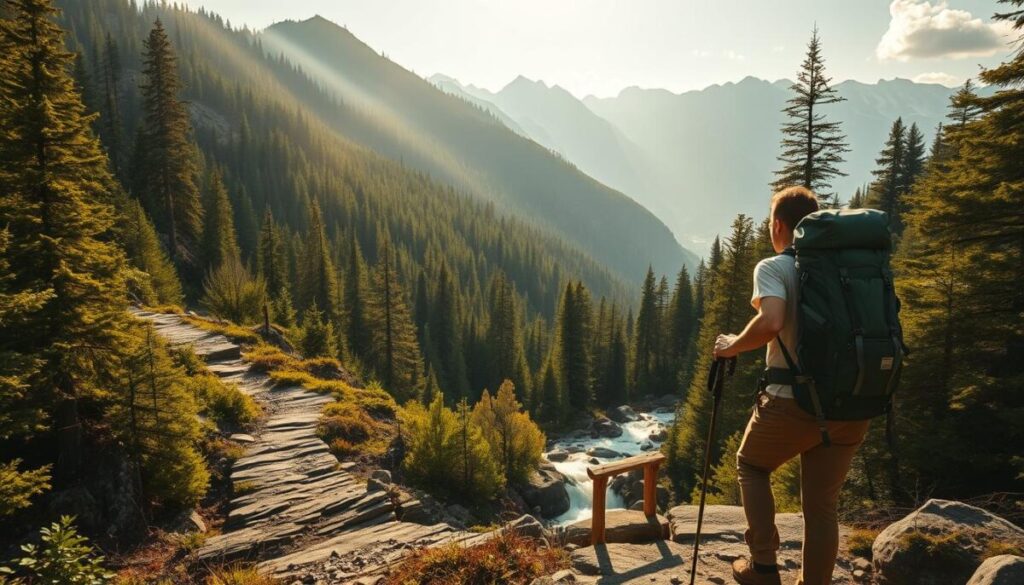
Ready to hit the trails? Backpacking is a great way to get away from it all and connect with nature. It’s a chance to step away from the world and find peace in the environment.
Before you go on your next adventure, you’ll want to know the essential tips. These tips will help make your trip safer, lighter, and memorable. This article will give you a detailed guide on how to start backpacking. You’ll learn about planning and preparation.
Key Takeaways
- Learn how to plan and prepare for a safe and enjoyable backpacking experience.
- Discover the essential gear and equipment needed for backpacking.
- Understand the importance of packing light and efficiently.
- Get tips on how to navigate and stay on track during your adventure.
- Find out how to make your backpacking trip unforgettable.
Planning Your Backpacking Adventure
Planning a backpacking trip needs careful thought. You must pick the right trail and get ready for the weather. It’s about making sure your trip is safe and fun.
Choosing the Right Trail for Your Experience Level
Choosing a trail is key. Think about your skill level and how fit you are. Beginners should pick trails that are easy and don’t go up too high. More seasoned backpackers can handle tougher trails.
- Use online guides and backpacking resources to find trails that fit your skill level.
- Look at the trail’s length, how high it goes, and any dangers like animals or bad weather.
- Talk to other backpackers and read reviews to learn about the trail’s conditions and any challenges.
Choosing the right trail is very important for a great backpacking trip. Picking a trail that matches your experience level means you’ll have a safer and more enjoyable time.
Weather Patterns and Seasonal Considerations
Knowing about the weather and seasons is key for a safe trip. The time you pick for your trip will affect the weather you’ll face.
Weather can change quickly, so being ready is essential. Check the forecast before you go and be ready for unexpected weather changes.
- Learn about the typical weather for the area and time of year you plan to go.
- Bring clothes and gear that can handle different weather.
- Be ready for extreme weather like thunderstorms or snow.
As a backpacker, knowing about the weather and seasons helps you prepare for challenges. It makes your adventure better.
Comprehensive Backpacking Guides for Different Terrains
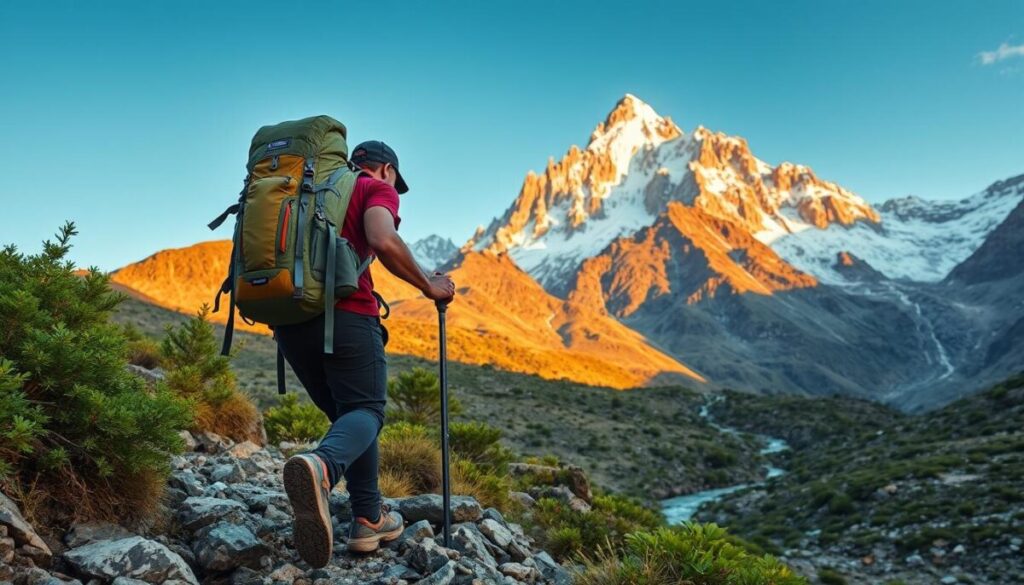
Understanding the terrain is key to a great backpacking trip. Each place has its own needs for safety and fun. You’ll need the right gear for a good time.
Mountain Backpacking Essentials
Mountains are tough due to weather and trails. Pack layers for changing weather and strong gear for rough paths. A waterproof jacket and insulated layers are a must.
- Use trekking poles for added stability on steep or slippery trails.
- Choose a backpack with a rain cover to keep your gear dry.
- Plan your itinerary around weather changes.
Desert Backpacking Considerations
Deserts are hot and water is scarce. Carry enough water and sun protection. A hydration bladder makes drinking water easy.
Key desert backpacking tips include:
- Carrying a water filter or purification tablets.
- Wearing lightweight, breathable clothing.
- Protecting your skin with sunscreen and a hat.
Forest and Woodland Trail Tips
Forest backpacking means knowing wildlife and terrain. Be ready for mud and wildlife. Keep food safe and stay alert.
- Use bear-resistant containers or hang your food when necessary.
- Stay on marked trails to avoid getting lost.
- Bring a map and compass, even if you have a GPS device.
Quality, lightweight gear is worth it for regular backpacking. It may cost more at first, but it lasts longer and saves money.
Essential Gear Checklist for Backpackers
Before you start your backpacking trip, make sure you have all the right gear. The right equipment makes your trip better, keeping you ready for anything the trail throws your way.
The Big Four: Shelter, Sleep System, Backpack, and Cooking Gear
The core of any backpacking trip is The Big Four: shelter, sleep system, backpack, and cooking gear. Each is key to your comfort and safety.
- Shelter: A light tent that keeps you dry is a must. Think about the weather and season of your trip.
- Sleep System: This means a sleeping bag and pad. Your sleeping bag should match the low temperatures, and your pad should be comfy and warm.
- Backpack: Your backpack should be comfy and big enough for your trip. Look for weatherproofing and lots of pockets for organization.
- Cooking Gear: You’ll need a stove, pot, and utensils for food. Think about the fuel, weight, and size of your pot.
| Gear Category | Key Features | Considerations |
|---|---|---|
| Shelter | Lightweight, waterproof, easy to set up | Seasonality, weather resistance |
| Sleep System | Appropriate temperature rating, insulation | Comfort, packability |
| Backpack | Comfortable, weather-resistant, organized compartments | Capacity, weight distribution |
| Cooking Gear | Portable, efficient, durable | Fuel type, cooking time, pot size |
Clothing and Footwear Selection
Choosing the right clothing and footwear is key for a good backpacking trip. Think about the weather, terrain, and what you might face.
- Clothing: Wear layers that you can add or take off. Choose clothes that dry fast and wick away moisture.
- Footwear: You need sturdy, waterproof boots or trail shoes. Think about the terrain, your style, and if you need ankle support.
By picking the right gear for your trip, you’ll have a safer and more fun adventure.
Lightweight Packing Strategies for Multi-Day Hikes

For backpackers, learning to pack light is key for long hikes. It’s not just about cutting down on items. It’s about choosing gear that does more than one thing and keeps your pack light.
Weight Distribution Principles
Getting your pack’s weight right is vital for comfort and balance. A balanced pack helps you move better and lowers injury risk. Place your heaviest items, like food and water, near your back and in the middle of your pack.
Use packing cubes or compression sacks to organize and compress your clothes. This helps spread the weight evenly and makes finding items easier without unpacking everything.
Multi-Purpose Gear Solutions
Choosing multi-purpose gear is a great way to lighten your pack. For example, a trekking pole can also be a tent pole or camera stick. Clothes that do more than one thing, like a waterproof jacket that also keeps you warm, are also great.
Look for “ultralight” gear that’s both light and durable. Invest in quality gear that might cost more but lasts longer and works better.
| Gear Item | Multi-Purpose Use | Weight Savings |
|---|---|---|
| Trekking Poles | Can be used as tent poles or camera sticks | Up to 0.5 lbs |
| Waterproof Jacket | Provides insulation and can be used as a picnic blanket | Up to 1 lb |
| Quick-Dry Towel | Can be used as a picnic mat or for drying dishes | Up to 0.2 lbs |
While cutting down on weight is important, don’t forget about comfort. A camp pillow might seem like a luxury, but it can be a nice treat after a long day.
Food and Water Management on the Trail
Managing food and water is key for a great backpacking trip. Being far from town means you need good food and water. This keeps you energized and healthy.
Effective food and water management includes planning meals, finding clean water, and storing food safely. This prevents wildlife from being attracted to your camp.
Meal Planning for Multi-Day Hikes
Planning meals for a long hike is more than just snacks. You must think about food’s nutritional value, weight, and how to prepare it on the trail.
- Choose lightweight, high-calorie foods that are rich in nutrients.
- Consider dehydrated meals that can be easily rehydrated with boiling water.
- Don’t forget to pack a water filter or purification tablets to ensure access to clean drinking water.
Nutritional Balance is key. Aim for a mix of carbohydrates, proteins, and fats to keep your energy levels stable. For example, a meal of dehydrated chicken with rice and vegetables provides a balanced mix of these nutrients.
Water Purification Methods
Having clean drinking water is vital. There are several ways to purify water on the trail, including:
- Boiling: Bringing water to a boil is one of the most effective methods of purification.
- Filters: Using a water filter can remove particulate matter and some bacteria.
- Chemical Purification: Tablets or drops can be used to kill bacteria and viruses.
- UV Purification: Some portable UV devices can purify water in just a few minutes.
It’s essential to understand the limitations of each method and choose the one that best suits your needs and the environment you’re in.
Food Storage and Wildlife Safety
Proper food storage is critical to prevent attracting wildlife to your campsite. Use airtight containers to store food and keep it away from your campsite.
- Hang food bags at least 10 feet off the ground and 4 feet out from the trunk.
- Use bear-resistant containers if you’re in areas known to have bears.
- Keep your campsite clean, disposing of trash and leftovers properly.
By following these guidelines, you can enjoy your backpacking trip while minimizing your impact on the environment and ensuring your safety around wildlife.
Wilderness Safety and Navigation Tips

To have a safe and fun backpacking trip, being ready for surprises is key. You need physical strength, mental bravery, and the ability to navigate.
Map and Compass Skills
A map and compass are vital for finding your way in the wild. Even with GPS, knowing how to use a map and compass is important. Learning to read a topographic map and use a compass can save your life if your GPS breaks.
To navigate well with a map and compass, you must know how to align your map with the area. You also need to spot landmarks and use triangulation to find your spot.
GPS and Digital Navigation Tools
While map and compass skills are vital, GPS and digital tools are also very helpful. GPS devices and apps give you precise location info and help track your path.
But remember, GPS and phones can lose power or get weather damage. Always carry extra power and know how to use your GPS with a map and compass.
Emergency Preparedness and First Aid
Even the most skilled backpackers can face accidents. Being ready for emergencies is key to staying safe. Having a first aid kit and knowing how to use it can help in medical crises.
- Learn to treat common injuries like blisters, sprains, and broken bones.
- Be ready for serious emergencies like allergic reactions or heart attacks.
- Keep emergency numbers handy and know how to use your GPS or phone to call for help.
By mastering map and compass skills, using GPS and digital tools, and being prepared for emergencies, you can have a safe and fun backpacking adventure.
Budget Backpacking Advice for Beginners
Starting a backpacking trip doesn’t have to cost a lot. With some planning and smart choices, you can explore the outdoors without spending too much.
Affordable Gear Options Without Compromising Quality
Looking for backpacking gear on a budget? There are ways to save money without losing quality. Here are some tips:
- Buy last season’s models at a discount.
- Shop during sales events or use coupons.
- Explore online marketplaces for gently used gear.
- Rent gear for your first few trips to see what you really need.
Some brands offer affordable gear without losing quality. For example, you can find budget-friendly backpacks, sleeping bags, and tents from brands like REI Co-op, Coleman, and MSR.
| Gear | Brand | Price Range |
|---|---|---|
| Backpack | REI Co-op | $80-$150 |
| Sleeping Bag | Coleman | $50-$100 |
| Tent | MSR | $200-$300 |
Money-Saving Strategies for Food and Transportation
Food and transportation costs can add up when backpacking. Here are some tips to save money:
For food, plan meals around what’s in season and on sale. You can also save by repackaging food and using a water filter instead of bottled water.
- Plan meals around seasonal produce.
- Repackage food to avoid waste.
- Use a water filter or purification tablets.
For transportation, use public transport or carpool with other backpackers. If renting a car, compare prices to find the best deal.
Budget Breakdown Example:
| Expense | Cost |
|---|---|
| Gear | $300 |
| Food (per day) | $10 |
| Transportation (round trip) | $50 |
By being mindful of your expenses and making smart choices, you can enjoy backpacking without overspending.
Conclusion: Taking Your Backpacking Skills to the Next Level
Now that you have your gear ready, it’s time to pack and hit the trail. By following the backpacking tips in this article, you’re on your way to a great outdoor adventure.
To improve your backpacking, focus on better planning and preparation. Try new outdoor adventure tips, like learning advanced navigation or making new recipes on the trail.
As you gain more experience, you’ll find areas to improve and make changes. Your next steps might include exploring new trails, trying different gear, or joining a backpacking community.
By always learning and growing, you’ll be ready for more challenging trips. You’ll enjoy the many rewards that backpacking offers.
FAQ
What are the most essential items to pack for a backpacking trip?
How do I choose the right trail for my experience level?
What are some tips for packing lightly for a multi-day hike?
How do I purify water on the trail?
What are some budget-friendly gear options for backpacking?
How do I plan meals for a multi-day backpacking trip?
What are some wilderness safety tips for backpacking?
How do I store food safely while backpacking?
Frequently Asked Questions
- Q: What are the most essential items to pack for a backpacking trip?
- A: The big four are key: shelter, sleep system, backpack, and cooking gear. They ensure a safe and comfy backpacking trip.
- Q: How do I choose the right trail for my experience level?
- A: Look for trails that fit your skill level. Check distance, elevation, and terrain. Ask park rangers or experienced backpackers for advice.
- Q: What are some tips for packing lightly for a multi-day hike?
- A: Spread out the weight and use gear that does more than one thing. Pack only what you need. Choose lightweight options like a portable stove or a light tent.
- Q: How do I plan meals for a multi-day backpacking trip?
- A: Choose meals that are high in calories and light. Use dehydrated or freeze-dried meals. Pack snacks like nuts, dried fruits, or jerky to stay energized.
- Q: How do I store food safely while backpacking?
- A: Use bear-resistant containers or hang food and trash bags. Keep them 10 feet off the ground and 4 feet out from the trunk to avoid attracting wildlife.
Share :
You Might Also Like

